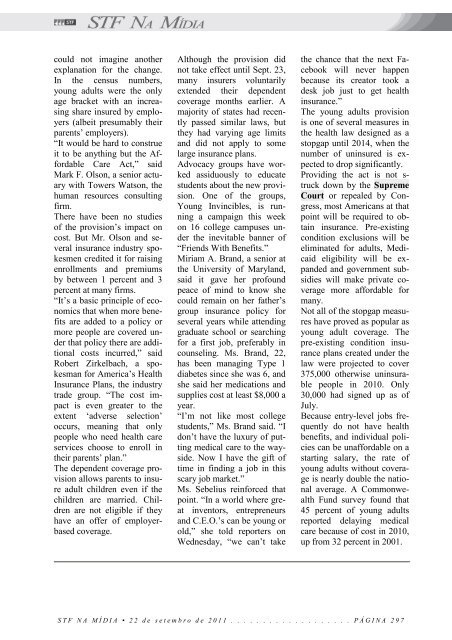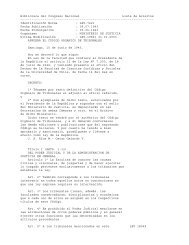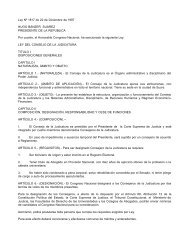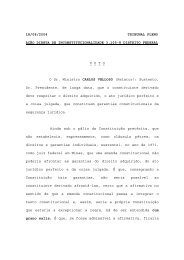STF NA MÍDIA
STF NA MÍDIA
STF NA MÍDIA
You also want an ePaper? Increase the reach of your titles
YUMPU automatically turns print PDFs into web optimized ePapers that Google loves.
could not imagine another<br />
explanation for the change.<br />
In the census numbers,<br />
young adults were the only<br />
age bracket with an increasing<br />
share insured by employers<br />
(albeit presumably their<br />
parents’ employers).<br />
“It would be hard to construe<br />
it to be anything but the Affordable<br />
Care Act,” said<br />
Mark F. Olson, a senior actuary<br />
with Towers Watson, the<br />
human resources consulting<br />
firm.<br />
There have been no studies<br />
of the provision’s impact on<br />
cost. But Mr. Olson and several<br />
insurance industry spokesmen<br />
credited it for raising<br />
enrollments and premiums<br />
by between 1 percent and 3<br />
percent at many firms.<br />
“It’s a basic principle of economics<br />
that when more benefits<br />
are added to a policy or<br />
more people are covered under<br />
that policy there are additional<br />
costs incurred,” said<br />
Robert Zirkelbach, a spokesman<br />
for America’s Health<br />
Insurance Plans, the industry<br />
trade group. “The cost impact<br />
is even greater to the<br />
extent ‘adverse selection’<br />
occurs, meaning that only<br />
people who need health care<br />
services choose to enroll in<br />
their parents’ plan.”<br />
The dependent coverage provision<br />
allows parents to insure<br />
adult children even if the<br />
children are married. Children<br />
are not eligible if they<br />
have an offer of employerbased<br />
coverage.<br />
Although the provision did<br />
not take effect until Sept. 23,<br />
many insurers voluntarily<br />
extended their dependent<br />
coverage months earlier. A<br />
majority of states had recently<br />
passed similar laws, but<br />
they had varying age limits<br />
and did not apply to some<br />
large insurance plans.<br />
Advocacy groups have worked<br />
assiduously to educate<br />
students about the new provision.<br />
One of the groups,<br />
Young Invincibles, is running<br />
a campaign this week<br />
on 16 college campuses under<br />
the inevitable banner of<br />
“Friends With Benefits.”<br />
Miriam A. Brand, a senior at<br />
the University of Maryland,<br />
said it gave her profound<br />
peace of mind to know she<br />
could remain on her father’s<br />
group insurance policy for<br />
several years while attending<br />
graduate school or searching<br />
for a first job, preferably in<br />
counseling. Ms. Brand, 22,<br />
has been managing Type 1<br />
diabetes since she was 6, and<br />
she said her medications and<br />
supplies cost at least $8,000 a<br />
year.<br />
“I’m not like most college<br />
students,” Ms. Brand said. “I<br />
don’t have the luxury of putting<br />
medical care to the wayside.<br />
Now I have the gift of<br />
time in finding a job in this<br />
scary job market.”<br />
Ms. Sebelius reinforced that<br />
point. “In a world where great<br />
inventors, entrepreneurs<br />
and C.E.O.’s can be young or<br />
old,” she told reporters on<br />
Wednesday, “we can’t take<br />
the chance that the next Facebook<br />
will never happen<br />
because its creator took a<br />
desk job just to get health<br />
insurance.”<br />
The young adults provision<br />
is one of several measures in<br />
the health law designed as a<br />
stopgap until 2014, when the<br />
number of uninsured is expected<br />
to drop significantly.<br />
Providing the act is not s-<br />
truck down by the Supreme<br />
Court or repealed by Congress,<br />
most Americans at that<br />
point will be required to obtain<br />
insurance. Pre-existing<br />
condition exclusions will be<br />
eliminated for adults, Medicaid<br />
eligibility will be expanded<br />
and government subsidies<br />
will make private coverage<br />
more affordable for<br />
many.<br />
Not all of the stopgap measures<br />
have proved as popular as<br />
young adult coverage. The<br />
pre-existing condition insurance<br />
plans created under the<br />
law were projected to cover<br />
375,000 otherwise uninsurable<br />
people in 2010. Only<br />
30,000 had signed up as of<br />
July.<br />
Because entry-level jobs frequently<br />
do not have health<br />
benefits, and individual policies<br />
can be unaffordable on a<br />
starting salary, the rate of<br />
young adults without coverage<br />
is nearly double the national<br />
average. A Commonwealth<br />
Fund survey found that<br />
45 percent of young adults<br />
reported delaying medical<br />
care because of cost in 2010,<br />
up from 32 percent in 2001.<br />
S T F N A M Í D I A • 2 2 d e s e t e m b r o d e 2 0 1 1 . . . . . . . . . . . . . . . . . . . P Á G I N A 2 9 7
















